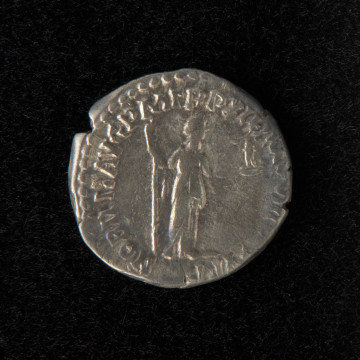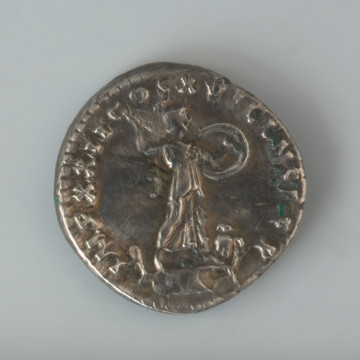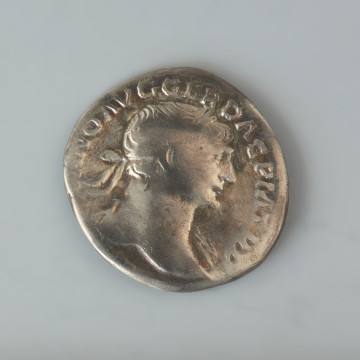
Denarius of Commodus
177 — 192
National Museum in Szczecin
Part of the collection: Antiquity
The denarius (a silver coin) of the Roman Emperor Caracalla was minted between 210 and 213 AD, and it was found before 1831. Coin’s surfaces are not tattered, and the depictions and inscriptions are still legible. The obverse depicts the Emperor’s bust turned to the right, with a laurel wreath on his head. Around it, there is an inscription ANTONINVS PIVS AVG BRIT. The reverse side illustrates the erect, half-naked figure of the Mars god, looking to the right, wearing a chlamys-type robe (type of a loose coat) lowered to his hips. The god is also wearing a Greek hoplite helmet, Corinthian type, and his face is uncovered. His right raised hand holds an olive branch - a symbol of peace, and the god’s left hand rests on the shield, which stands on the ground, and a spear is visible behind the shield. Around the figure, there is an inscription MARTI PACATORI. The imitation refers to the Mars attribute, which was the use of military power to secure peace. There are many theories on the Roman coins’ function in the Polish territories. The earliest speculations on collecting them for melting and remaking in the form of jewellery are being denounced. The most plausible hypothesis states that the Roman coins were used for internal and external (between tribes) trade. Initially, it was believed that the exchange of goods occurred only between the Roman merchants and representatives of tribal elders. The coin influx on the territories far away from the Empire has considerably increased in the 2nd century, which is related to trade routes and demand for amber.
Monika Witek
Author / creator
Dimensions
cały obiekt: diameter: 18 mm
Object type
exchaneg media; money; coin; denarius
Technique
forming; punching
Material
silver
Creation time / dating
Creation / finding place
Owner
Muzeum Narodowe w Szczecinie
Identification number
Location / status

177 — 192
National Museum in Szczecin

92 — 93
National Museum in Szczecin

National Museum in Szczecin
DISCOVER this TOPIC
National Museum in Lublin
DISCOVER this PATH
Educational path